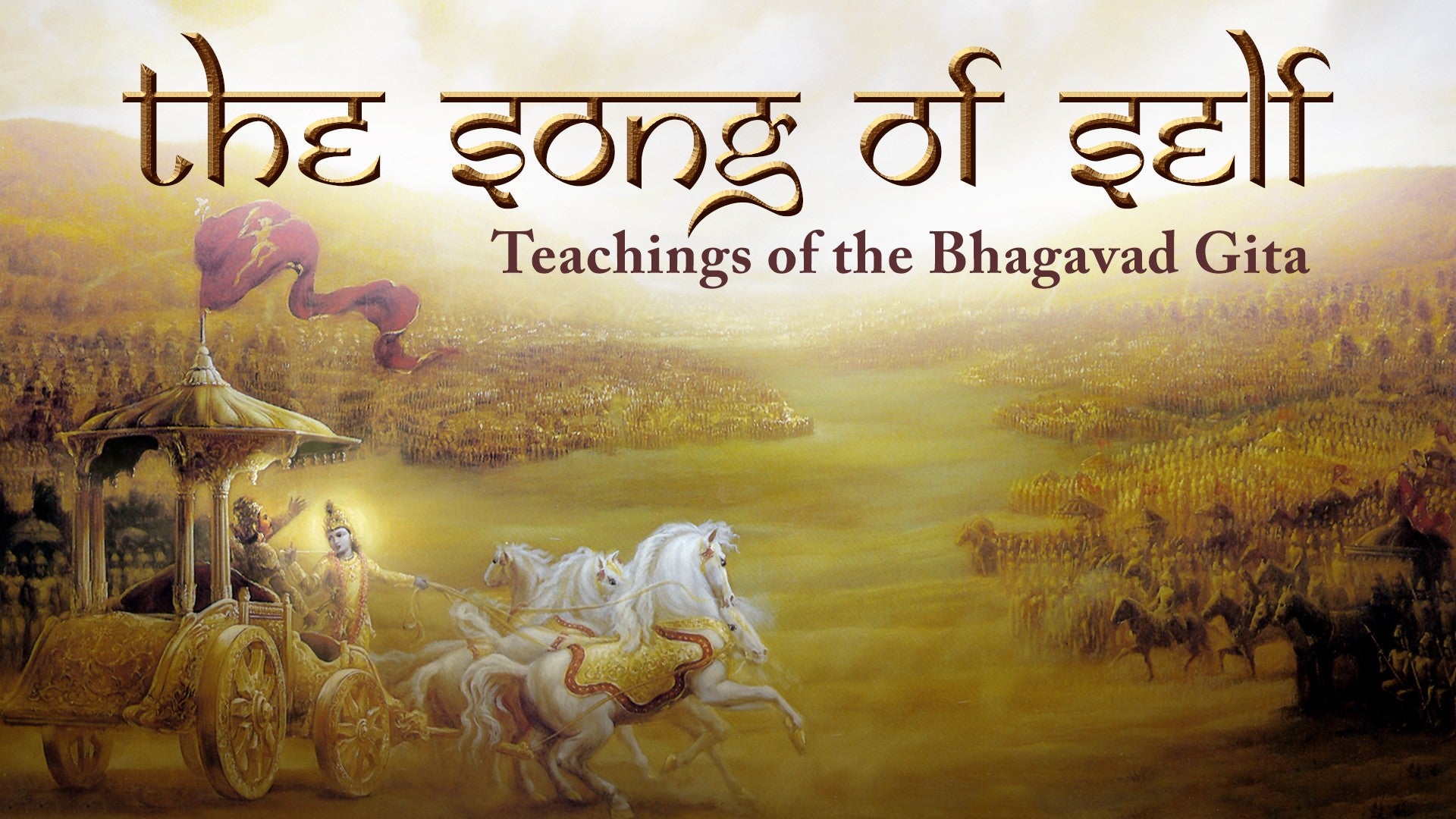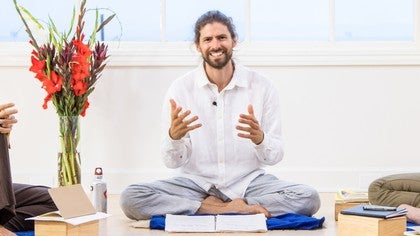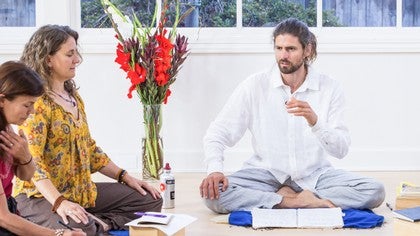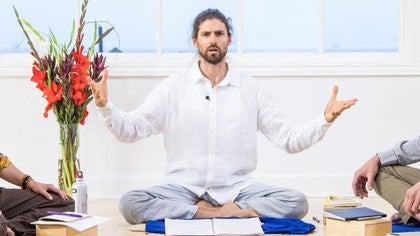Description
About This Video
Transcript
Read Full Transcript
So now, the forty-six verse. So here we have this comparison. As much as, so much. So he says, Krishna says, as much use as is the amount of water that you can fit in your cupped hands, when the whole land is in flood, so much use are all the Vedas to the Brahmana who truly knows reality. In other words, the one who has come to an understanding of totality.
Brahmana means totality. Brahmana means one who understands that. So all of the Vedas, in other words, once you understand totality, all the Vedas are as much use as the amount of water you can fit in your own two hands, when all around there is a flood. So what's Krishna saying here? At a certain level it can look like he's discrediting the Vedas.
What he's really saying is that the place the Veda is intended to take you to is so much greater than the teachings. And so, this is one of my very favorite verses. I just love the way that Krishna makes it so explicit. Don't confuse the teachings for the place they're intended to invite you to experience. Don't mistake the texts or the technique for what they are intended to allow you to actually experience.
And so as emphasizing, the experience is always greater than the way we can possibly describe it. Because really, once we're in the realm of yoga, we're in the realm of experiential understanding. And so all these words are just a gesture, an indication that they're ushering us in that direction. Now also in this verse, Krishna's kind of warning us, don't confuse the technique for the end. Sometimes people have the idea, oh, if I'm doing well in yoga, it means that I'll be able to do this technique.
So let's say somebody, for example, is practicing yoga asana, they might think, oh, I'll be doing better once I can execute that particular posture, or when I can fly in the sky, then I'll be a really good yogi, for example. But progress in yoga is never measured by capacity to execute a particular technique. It's always identified because we actually feel closer to that integration in our day to day, in the real testing ground of practice. So sometimes people make the mistake, oh, yoga is what I do when I get out my asana mat. Or I do my yoga when I sit on my meditation cushion.
And then I get on with the rest of the day. In the yoga tradition, there's the idea that actually practice is everything we do. It's all the time. And this is outlined very beautifully by Patanjali in his yoga sutra. In the first chapter of the yoga sutra, Patanjali defines yoga practice.
It's the 13th and 14th sutras of chapter one in the yoga sutra, and Patanjali says, tathras tathayatna pyaasa han, and then he says, satu tirgakal nairantari satkarasevitudr dabhumi hi. So in the 12th sutra, he introduced a pyaasa, practice, and this concept called vairagya as the means to cultivate yoga, as the means to overcome the tendency to be dispersed and instead to be able to be steady and present and integrated. A pyaasa practice, he defines it. It is the yadna, the steady, committed effort, yadna really means efforts, the effort, the engagement for the sake of sthiti, for the sake of steadiness. Moreover that is dirgakala for a long time, nairantariya, without interruption, satkaras, attended to with real presence, asevita, and a spirit of devotion, tridabhumi hi.
Then that practice becomes well and firmly rooted, it becomes grounded. And then, then, Patanjali introduces vairagya. Now vairagya often gets translated as non-attachment, so the 12th sutra Patanjali says you can cultivate yoga through practice and non-attachment. Now sometimes when people see this they think, well straight away there's a contradiction. Because if you're supposed to practice all the time, surely you've got to be attached to your practice.
So this Patanjali, he's just contradictory and they reject it. But what does Patanjali say? He says a pyaasa and then vairagya. In Sanskrit it's a compound word and the order in the compound is very instructive. First a pyaasa, then vairagya.
So after Patanjali defines a pyaasa as the sustained, unbroken, wholehearted, steadfast effort to secure steadiness, he goes on to describe vairagya. And he says, drishta anushravika vishaya vitrishnasya vashikara sanghya vairagyaam. So he defines vairagya, drishta anushravika vishaya vitrishnasya, vashikara sanghya vairagyaam. So it's very interesting, in this sutra Patanjali uses the word vitrishna, which means free from thirst. If your hands are full of water, you're not going to be thirsting.
Patanjali says drishta, things you've seen, things you've already experienced, anushravika, things you've just heard or read or been told about, vishaya, objects. So objects you've already experienced, you have direct experience of, or objects you've only heard about, you are not thirsting for any of those things. Why not, vashikara sanghya vairagyaam, because you've already recognized that those things that come and go are not as deep a source of satisfaction as the fullness you feel when you actually bring everything into the present moment. And that is vairagya. In other words, vairagya is not something that you practice, it is the natural consequence of practice.
Just like fullness, or when I say fullness, not feeling thirsty is the natural consequence of having a steady supply of nourishing liquid. It's the idea, Krishna says it so beautifully, all the veda, they're as much used as the amount of water you can fit in your hands when the whole water is in flood, when the whole land is in flood. So there's a whole realm of practices we can work with, but maybe we don't need to try them all. We can just cultivate that fullness. Does your practice make you feel fully present?
If it does, then you know it's working. You mentioned already, in the Upanishads, one way that our essence is described is a real, present, existing, chit, conscious, and ananda, full or blissful. So rather, sometimes people think, oh, I know I'll be getting good at yoga when I can stand on one hand and wrap my foot behind my head, or when I can just drop into samadhi and then teleport myself and communicate telepathically with all those ancient sages, for example. But the idea is we'll know we're making progress in yoga in a much easier way. Do we feel more sat?
Do we feel more chit? Do we feel more ananda? Is our practice making us feel more present? Is it expanding our awareness? And is it making us feel fuller, more at home, here and now, in our own skin, in the grounded reality of where we actually find ourselves?
So take care. Don't get lost in the teachings. Just use the teachings to help us navigate where we really are, here and now.
The Song of Self: Bhagavad Gita: Chapter 2
Comments

You need to be a subscriber to post a comment.
Please Log In or Create an Account to start your free trial.








